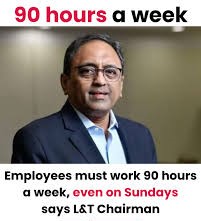Increased working hours impact the physical and mental condition of human beings. Idealising working in excess comes under the category of ‘workaholic’ or work addiction which is an unhealthy mental obsession termed ‘obsessive-compulsive disorder’ (OCD) in psychology. In Japan, the death from overwork is famously called ‘Karoshi’. Psychiatrists have developed the ‘Bergen Work Addiction Scale’ to measure it. It may be an obsession of some of the top business managers and CEOs, but the problem arises when they compel others below also to follow the abnormality. WHO and ILO find long hours of work an occupational risk factor leading to diseases or early death. In 2021, a WHO report about 194 countries said that long hours of work are a serious health hazard and kill hundreds of thousands of people a year.
Industrial fortunes should not be built upon the graveyard of workers. Business leaders should consider workers human beings, not cogs in a giant machine. Sustaining work-life balance and productivity should go together. The worker toils hard to earn his livelihood and the employer makes profits out of his labour. Workers want to sustain their life and their family. They have dreams about their children’s future and need time to spend with family. A Godrej Interio survey in 2019 said 64% of professionals in India are not able to spend enough time with their family and children due to work pressure.
ILO reports “excessive” working time as a concern. In ILOSTAT, statistics are provided about persons who work more than 48 hours a week. ILO classifies long hours as voluntary or involuntary (when imposed by employers). Its study, ‘Working Time in the Twenty-first Century’ (2011) says 41% of countries have implemented 40 hour work week. Decent working hours have to be ensured for the workers. According to the OECD, the Netherlands, Denmark and Norway are the major countries with the lowest working hours in the world. In countries like Sweden, it is 30 hours. Japan has the highest working hours among G7 countries. But workaholic Japan lags behind the US, Europe and other countries in productivity.
China had the notorious ‘996’ work culture, i.e., working from 9 am to 9 pm, and 6 days a week. The world saw one of the largest online labour protests in 2019 terming ‘996’ as “modern slavery” which the Chinese Government tried to crack down. Studies related to ‘996’-culture estimated that more than three-quarters of urban workers in big cities like Beijing, Shanghai, and Guangzhou suffer from work-related fatigue, musculoskeletal pain, sleep or eating disorders, occupational stress, and work-family imbalance. Overwork deaths and suicides were also reported.
India is one among the most overworked countries in the world ranking second for prolonged working hours. CII survey also reports that 62% of Indian workers burn out three times the global average. Wherever unionisation is very weak, employers frequently flout the norms on working hours. The daily working hours for those in certain newly emerging sectors in India like the delivery boys in the gig economy are atrocious, and their targets are extremely difficult to achieve. Most of the state governments irrespective of their political affiliations have raised working hours by amending labour laws. In India the Factories Act of 1948 and the new OSH&WC Code, 2020 mandate 48 hour work week and spread over (including intervals of rest) ranging from 10.5 to 12 hours per day. India should be a model for other countries in respecting International Labour Standards set by ILO. Our nation should not be made a global hub of exploitation and forced work.
It is to be remembered that India had walked into history by pioneering the struggle for eight hours work about 24 years before the May Day incidents that happened in Chicago. During April-May of 1862, about 1200 railway workers in Howrah (Kolkata) went on strike demanding the same. ILO adopted its 1st convention as early as 1919 insisting on a cap of eight hours working per day for all its member countries. It maintained the scientific idea of eight hours of working, eight hours of rest and eight hours of leisure constituting a division of 24 hours a day. India has already ratified the convention. Dr Ambedkar declared eight hours of work for India at the 7th Indian Labour Conference held in 1942.
Shri Dattopant Thengadi, the founder of Bharatiya Mazdoor Sangh (BMS), proposed ‘flexible working hours’ as workers’ choice as early as 1975 in the Amritsar Conference. It will increase productivity and add to work-life balance. It also helps working women to adjust their household work.
Long Working Hours Retard Productivity and Employment
Increased working hours negatively impact employment and productivity. It limits jobs in the hands of a few already inside, thereby denying it to the large army of job seekers waiting outside. Germany was able to quickly reduce unemployment after the global financial crisis as well as during COVID 19 by adopting the “Kurzarbeit scheme” with shorter working hours. Belgium, France and Italy, also adopted it. In a country like India where the youths are waiting for jobs, reducing working hours is a social and moral obligation of the employers.
Ergonomic studies say workers’ productivity is higher in the initial hours of the day and gradually decreases after hours of continuous work and fatigue. Hence reasonable working hours are essential for increasing productivity, says ILO. The International Organisation of Employers (IOE) also has supported this idea.
Productivity is measured by output per hour worked. Some studies report that the productivity of a German worker is 7.8. times more than an Indian worker. To match this, asking the Indian worker to work more is a medieval idea to convert the labour market into a slave market. The way out is raising the productivity per hour and not increasing working hours.
In 1962 ILO adopted the principle of the progressive reduction of normal working hours through its Recommendation No.116. Sweden’s 30-hour experiment has sharply reduced absenteeism and improved productivity and workers’ health. In 2014 when Microsoft tried 4-day work per week in 2019 in Japan, under the name “Work-Life Choice Challenge”, the productivity jumped 40%. With increased automation also, the benefits of escalation in productivity should be shared with the worker as increased wages and reduction of hours of work. -Shri. SajiNarayanan C.K. (Ex-President,BMS)






